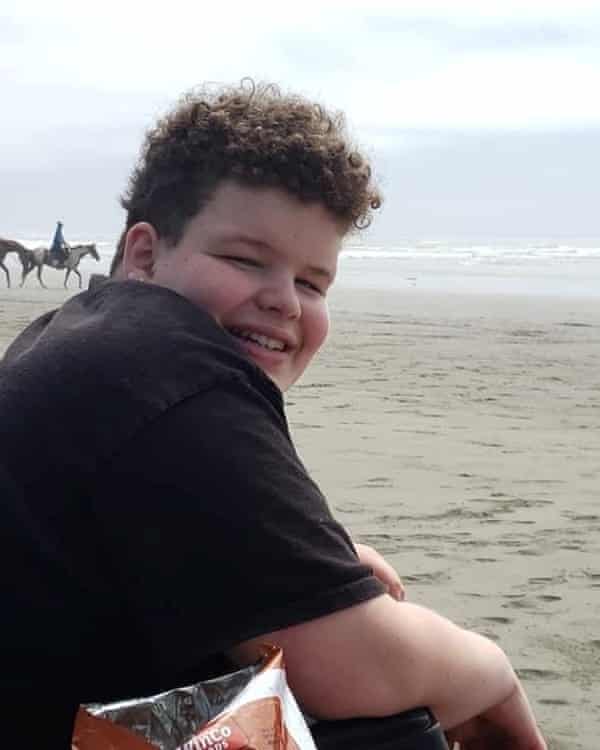It was August 2020, and Luca Manuel, 13, was starting eighth grade the following day in Redding, California. He was excited to see his friends; his mother had bought him a stash of masks and school supplies for his first in-person school day in six months.
But the week earlier, he’d gotten a root canal, and his mouth still hurt. He sent a message on Snapchat to find marijuana for the pain. Instead, the dealer said he had something better: Percocet.
Luca didn’t know that the pill, which had been pressed to look like the real pain medication, was actually a counterfeit laced with fentanyl, a substance 30 times more potent than heroin. He died of drug poisoning that afternoon, a video game looping like a ghost across the screen in front of him.
More than 100,000 people died from overdoses in the US in a 12-month period ending in April, according to the US Centers for Disease Control and Prevention.
It’s the biggest increase ever seen in the US – and it’s only rising each month, drug researchers say.
Fentanyl is driving the majority of these deaths, associated with at least 60% of the fatal overdoses – a 50% increase in a single year, Nora Volkow, director of the National Institute on Drug Abuse, told the Guardian.
“It’s devastating,” she said. “It’s an epidemic within the pandemic.” Deaths from fentanyl were already on the rise across the country, but the pandemic supercharged their speed and intensity.
It’s not unusual to see people turn to drugs or alcohol during times of crisis, Volkow said. “But what we didn’t expect was that during that period, there will be a massive increase in the entry of these illicit substances into the country.”
Dramatically more fentanyl is coming into the US, making the drug supply increasingly dangerous.
“The trajectory is up, with no leveling off,” Daniel Ciccarone, the Justine Miner endowed professor of addiction medicine at the University of California, San Francisco, said. “There’s nothing that says it’s slowing down.”
A “triple wave” of opioids, from pain pills to heroin to fentanyl, is wreaking havoc, he said.
“Fentanyl is an extraordinarily potent drug. It was manufactured specifically to be much more potent than morphine,” Volkow said. It’s also incredibly profitable, she said. “If someone is a drug dealer, they make much more money by selling fentanyl than by selling heroin or selling cocaine.”

Another alarming trend is arising with the dominance of fentanyl. People who have never used opioids before are dying from a single fatal encounter with fentanyl. “They are not opioid users, and they don’t know that these drug are contaminated and they die with one single exposure,” Volkow said.
Even for those who are accustomed to taking opioids, it can be difficult to judge a safe dosage of fentanyl. Most experienced drug users don’t prefer it, but as prescription pills and heroin became harder to get, dealers have increasingly begun mixing fentanyl into the supply.
Experts and grieving families are seeing alarming numbers of people, even children, taking what they think are legitimate Percocet or Xanax pills with friends.
“Counterfeit pills are a big part of the story,” Ciccarone said. High-quality pill presses can make the substance look like a legitimate medication. “They look for all the world like the real thing.”
Fentanyl has circulated along the east coast for about a decade, but it’s now moving out west, where “people are not accustomed to it, and don’t know how to use it”, he said. While fentanyl overdoses were first concentrated primarily among white populations, communities of color are now being hit harder than before.
“It’s going into new groups and causing devastation,” Ciccarone said.
There are some solutions, however. A medication, buprenorphine, can help those who are addicted to opioids and help prevent overdoses, and inexpensive test strips can detect the presence of fentanyl in other drugs. Housing stability can also help prevent substance use.
Fentanyl overdoses are reversible with the quick use of a medication called naloxone – but the price of naloxone has increased dramatically this year, creating a shortage for many of those who need the medication the most. “We just need more of it,” Ciccarone said.
The Biden administration recently announced harm reduction policies in order to stem the wave of overdoses, an encouraging move, Ciccarone said.
It’s also important to address the fundamental inequalities frequently driving the overdose crisis, Ciccarone said. “We’ll continue to have wave over wave over wave of drug overdoses unless we address the inequities in our society. It’s a wake-up call, and civilizations do fall if they don’t address the instabilities in their population.”
Amanda Faith Eubanks, Luca’s mother, remembers her son as a kind, sweet, trusting kid. On the morning of his last day, she shopped for groceries because he had asked to cook meals for a nearby homeless camp. “He thrived in service for others,” she told the Guardian. “He was just the kid that you could go to on any bad day. He had a heart of gold.”
“Fentanyl is unlike anything anybody’s seen before,” Eubanks said. “It’s a public safety crisis.”
Detectives in Luca’s case have charged the dealer with murder; his preliminary hearing will begin later this month. And Eubanks has begun speaking up, creating a support group for families grieving loved ones lost to fentanyl poisoning.
“I just don’t want more people dying from this,” she said. “I didn’t want any more moms to ever feel this.”